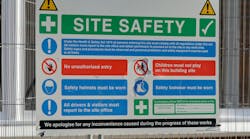Latest from Best Practices
Sponsored
By Rick Farrell, President, PlantTours
Though plumbing certainly wouldn’t end up on a list of the most dangerous professions, it comes with its own safety concerns. Not taking the necessary precautions on each job can result in serious injury and, in some cases, even death. So clearly, plumbing professionals need to be careful and carry proper equipment wherever they go.
Now you might be wondering—what are some common safety concerns plumbing professionals face? And what should they do to protect themselves? We’ll gladly answer both questions for you in the following list.
1. Heights
From time to time, plumbers have to manage pipes located high up—on rooftops and skyscrapers, for instance. Naturally, the risk of slipping and falling is great in these scenarios, and the consequences can be dire due to the height. So, following safety guidelines is of utmost importance.
For example, plumbers should only work at a height if the weather conditions allow it. In other words, if it’s raining or snowing, rooftops will likely get slippery and much more difficult to navigate. On top of that, visibility might be lower, too, putting the plumber at risk.
Using certified attachment points and harnesses is a must, but only once they’ve passed their regular inspections. Also, to protect themselves from falling objects and other similar hazards, plumbers should wear protective clothing, such as helmets, while they work.
2. Hazardous Chemicals
Before asbestos was outlawed in the 1970s, it was frequently used as a building material in cement shingles and roofing. Nowadays, we’re well aware of its adverse effects on health. Prolonged asbestos exposure may cause:
● Respiratory issues
● Permanent lung damage
● Lung cancer
● Cancer of the kidney, throat, or gastrointestinal tract
Unfortunately, buildings built before the 1970s still exist, and asbestos can be found in them. It often lurks in the floor tiles, insulation, and of course, pipes. In other words, plumbing professionals are at a high risk of exposure to it when they work in older homes.
Aside from asbestos, plumbers might come in contact with lead, another dangerous chemical that was often used in pipes and plumbing systems. Ingesting and inhaling lead particles may lead to:
● Headaches
● Joint and muscle pain
● High blood pressure
● Abdominal pain
● Difficulty with concentration or memory
Thus, whenever they are working in an older building, plumbers should make sure to bring masks, eye goggles, and gloves. They should also ask the property owner if there are any hazards and if the answer is yes, proceed with caution.
3. Hearing Damage
According to the National Institute of Occupational Safety, up to 48 percent of plumbers report some form of hearing loss. That’s a huge number but not entirely surprising. After all, plumbers frequently work with buzzing machinery, banging tools, and noisy pipes. Constant exposure to such noise is sure to damage hearing to some extent.
In order to prevent hearing loss, plumbers should consider buying high-noise headsets. Devices such as two-way communication headsets typically have built-in noise cancelation features that greatly reduce the strain on the wearer’s ears. On top of that, their microphones allow effortless communication with other wearers, which might be crucial during some phases of work.
4. Electrocution and Burns
In many homes, pipes that bring water, electricity, and gas are all bundled together, with only tags setting them apart. If they’re not correctly tagged, though, they can be tough to identify, which is a huge safety concern. After all, if a plumber makes a mistake and cuts the wrong pipe, the consequences can be dire.
For instance, coming into contact with bare wires almost certainly means electrocution, which can easily turn fatal. Similarly, if a plumbing professional cuts the gas pipe, there’s a danger of fire and explosion. In such a case, everyone on the premises would likely end up injured, not just the plumber.
To avoid these scenarios, plumbers need to double-check before touching any of the pipes. It’s always best to err on the side of caution and postpone the job until they can ensure their own and everyone else’s safety. ESD clothing and Protective gear are a must, too—gloves and eye goggles in particular.
5. Confined Spaces
Due to the nature of their job, plumbers frequently work in tight, confined spaces where oxygen levels are low. For example, they may end up in sewers, ducts, and storage tanks that aren’t intended for a prolonged stay. And if they aren’t careful, they can easily find themselves in a life-threatening situation.
That’s why it’s essential to first examine the job site and determine how long the work would take. If the plumber notices that breathing in a certain confined space might be a challenge, they must take measures to minimize the risk. In most cases, they should bring along some sort of breathing apparatus. And if possible, risky jobs of this kind should be performed in a team—that way, if anything goes wrong, other team members can help.
In Conclusion
Everyone who’s worked in plumbing knows that this profession is far from safe. The hazards are numerous and often unpredictable, so injuries are not uncommon. Sometimes, they can be debilitating or even fatal.
That’s why it’s crucial to be aware of the most common safety concerns, as well as ways to prevent them. Though some incidents may be impossible to avoid, it’s easier to properly handle them when you’re familiar with them. After all, your response to an incident can make a great difference in minimizing the consequences.
Farrell is North America’s foremost expert in improving manufacturing group communication, education, training, and group hospitality processes. He has over 40 years of group hospitality experience, most recently serving as President of PlantTours for the last 18 years. He has provided consulting services with the majority of Fortune 500 industrial corporations improving group communication dynamics of all types in manufacturing environments.


